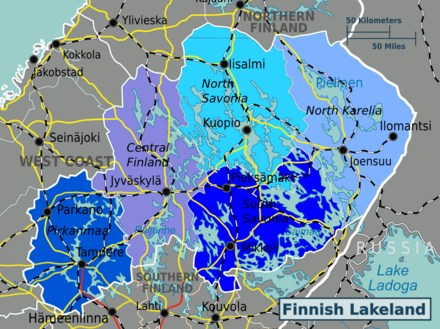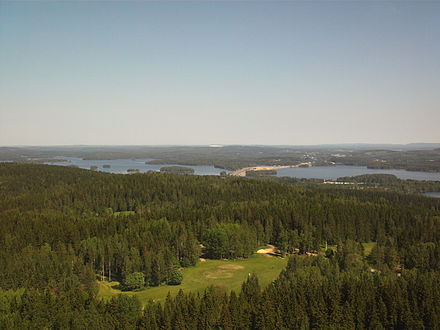Finnish Lakeland - largest of the four landscape regions into which the geography of Finland is divided
Finnish Lakeland (Järvi-Suomi) comprises the eastern and central parts of the country. Finland is known as the country of a thousand lakes (actually more than a hundred thousand), and this is the region where most of them are located.
Regions
The Finnish Lakeland is divided into five regions.

North Savonia is the home of many events from a strawberry festival to the wife carrying world championship. Other points of fame are the signature dish kalakukko (a loaf of bread stuffed with fried fish) and its recognisable dialect.
The culture of Finland's easternmost region carries influences of the Eastern Orthodox faith. If you want to see a bear or a wolf in its natural habitat, this is probably the destination to go.
Central Finland is remarkably hilly and you can experience some quite scenic drives on the smaller roads.
South Savonia is really the heart of the Lakeland - you are never far from a body of water. The most important sights here are the medieval castle Olavinlinna in the city of Savonlinna and the Punkaharju ridge that almost cuts through Lake Saimaa.
Pirkanmaa is usually seen as the heartland of Finnish heavy industry, and the city of Tampere has been called the "Finnish Manchester". However there are plenty to see and do in the city for the traveler — from museums and theatres to the amusement park Särkänniemi.
Cities
- Iisalmi (Swedish: Idensalmi) — northern town known for its Olvi brewery
- Joensuu — capital of North Karelia
- Jyväskylä — capital of Central Finland
- Mikkeli (Swedish: S:t Michel) — capital of South Savonia
- Kuopio — capital of North Savonia; home of kalakukko, the baked fish pie
- Pieksämäki — railway junction
- Savonlinna (Swedish: Nyslott) — famous for the picturesque medieval castle and the yearly Opera Festival
- Tampere (Swedish: Tammerfors) — the biggest inland town in Scandinavia and the second largest metropolitan area in Finland
- Varkaus — small industrial town
Other destinations
- Kangasala, home to famously beautiful lakes and ridges
- Kerimäki, the world's largest wooden church
- Koli National Park, which inspired many artists when Finnish nationalism awakened
- Helvetinjärvi National Park, popular natural destination known for its gorge valley formed during the Ice Age
- Kontiolahti
- Nokia, the former home of a certain rubber boot company that went high-tech
- Rautalampi
- Punkaharju, with a ridge that nearly divide Saimaa in two, a national landscape
- Saimaa 📍, the fifth largest lake in Europe, with thousands of islands
Understand
As the name reveals it is a land of lakes: seen from above, the region consists of an endless patchwork of lakes and low rolling hills, originally gouged out by sheets of ice during the Ice Age. This also makes it Finland's top destination for summer cottages, and there are countless spots to indulge in the Finnish national obsession for sauna, sausages and a dip in the lake.
There are several large lake systems with cruises (often on old steamers or former steamers) and possibilities for sailing with a yacht or daysailor, other kinds of boating and canoeing, for days or weeks if you like. Also on the smaller lakes you will often have access at least to a rowing boat.
Talk
The region is unilingually Finnish. Culturally, Eastern Finland is the home of the Savo people and their close cousins the Karelians. Much of Karelia has "always" belonged to Russia, and the Karelian-speaking areas that belonged to Finland were lost to the Soviet Union in World War II, with their inhabitants resettled across Finland. Most Karelians in Finland speak a dialect closer to mainstream Finnish, or just plain Finnish. Likewise, Savonian is just a dialect, although a famous one.
The border between western and eastern Finnish dialects roughly follows the western border of Central Finland and South Savo. At Pirkanmaa people speak North Tavastian dialects of the western group. The rest speak Savo dialects which are wordy and stretched out, with consonants doubling and diphthongs mutating in various ways. According to the stereotype, Savonians talk much more than the average taciturn Finn, yet despite this <small>(whisper it quietly)</small> almost Russian habit for speeches and gesticulation, they're also masters of the vague non-reply. Indeed, the canonical Savo response to any question is suattaapi olla, vuan suattaapi olla olemattannii, or "it might be, but it might also be that it's not".
Get in
By plane
Joensuu, Jyväskylä, Kuopio and Savonlinna have small airports with limited service from Helsinki only. Tampere is the Finnish hub for Ryanair and serves a handful of European destinations.
By train

All main cities in the region are served by train. Trains are usually faster and slightly cheaper than the bus, but on some routes bus schedules may be more convenient.
By bus
Buses fill in the gaps where trains don't go.
By boat
The Saimaa Canal provides access from the sea to Saimaa and connected waterways, covering most of the eastern part of the Lakeland, up to Iisalmi and Kiuruvesi in the north-west, Koli and Nurmes in the north-east and Mikkeli in the west. The Päijänne and Näsijärvi waterways are cut off from the sea by dams.
Get around
Distances are long and while the coach network covers most of the region, public transport outside the main cities and thoroughfares varies between limited and non-existent. If you're planning on staying at a cottage, having your own car is pretty much obligatory, unless in biking distance from services (whatever that means to you).
Most of the waterways in the eastern half of the region are connected to the lake Saimaa. Around Jyväskylä there are the Vesijärvi–Päijänne–Keitele waterways and around Tampere the Näsijärvi–Ruovesi and Längelmävesi–Vanajavesi waterways. Although a boat is seldom a time-efficient means to cover large distances, it is a very good means to explore some aspects of the Lakeland. Many of the lakes are big enough for nice sailing, the Saimaa complex for weeks even with a big yacht. For other areas a small boat or canoe is the ideal means.
By taxi
- Smartphone apps: Valopilkku, 02 Taksi, Menevä
See
- Saimaa (Saimen in Swedish) is a lake in the south of the Lakeland. At 1,147 square km (443 square miles), it is the largest lake in Finland, and the fifth largest in Europe. It is labyrinthine, with long arms and thousands of islands, and without one large open expanse, so very different from most other large lakes in Europe – you won't appreciate its size from the shore, but rather when exploring it, or from the map.
- The ridge landscape at Punkaharju, which is one of national landscapes of Finland.
- The world's largest wooden church in Kerimäki.
- The New Valamo monastery and Lintula Holy Trinity convent in Heinävesi, the only Orthodox monasteries in Nordic countries.
- WWII bunkers at the bunker museum in Joensuu.
- The Puijo tower in Kuopio, and the view from its viewing platform.
- Olavinlinna medieval castle, with an opera festival in Savonlinna.
- Koli National Park, one of the most often photographed landscapes from Finland.
- Linnansaari National Park consists of hundreds of islands in northern Saimaa. The most probable place to meet endemic Saimaa ringed seal.
- The wooden church of Petäjävesi, a .
- The 19th century industrial buildings in Tampere, "Finland's Manchester".
- Astuvansalmi rock paintings in Mikkeli and Saraakallio rock paintings in Laukaa.
- The Bomba house, a large, Karelian style log building in Nurmes.
Do

- There are nice spa hotels in Kuopio and Savonlinna. They offer large swimming pool departments with jacuzzis, children's pools, saunas, steam rooms and spa treatments also for day visitors. Spa hotels also organize many activities.
- Participate in the Wife Carrying World Championships in Sonkajärvi.
- Eat strawberries at Suonenjoki Strawberry Carnival in Suonenjoki.
- Take a boat tour across the lakes in a big boat or at your own pace in a rowing boat. During summertime there are cruises with historical steamboats on many of the lake systems.
- Take a glimpse to Karelian culture in North Karelia.
- Ruunaa National Hiking Area 📍 in Lieksa is one of the most popular hiking areas.
Nature
As the lakeside area and one of the most rural areas in Finland after Lapland, Eastern Finland has a lot to explore. There are a dozen national parks in the region, of which scenery of Koli National Park is one of Finland's national landscapes.
- Hike. In national parks and other hiking areas you can find several shorter and longer hiking trails with clearly marked paths, from easy to demanding. Hiking is also allowed anywhere thanks to everyman's right.
- Paddle. There are endless lakes and archipelagos to explore. Kolovesi, Linnansaari, Patvinsuo, Repovesi and Tiilikkajärvi National Park all provide good routes for canoeists, and you are by no means restricted to these.
- Sail or cruise with a yacht or motorboat. Saimaa allows any size of yacht, while daysailors or motorboats may be more handy on the other routes.
Eat
In Finland, Savo and Karelia are famous for their cuisine, which has distinctive eastern trait. There are a couple of eastern Finnish specialties definitely worth sampling:
- Kalakukko, a type of large rye bread pastry with fish and meat stuffed inside, can be eaten warm or cold. Kalakukko is Savonian specialty and has got Traditional Speciality Guaranteed (TSG) status in the European Union.
- Lörtsy, a large, flat variant of the ubiquitous deep-fried meat pie (lihapiirakka), can also be stuffed with apple jam. Specialty in Savonlinna.
- Vendace (muikku), a small freshwater fish. Most commonly coated with rye flour, quickly fried and eaten while piping hot.
- Karjalanpiirakka – the Karelian pie – is a special kind of pastry made from rye flour and filled with rice porridge or mashed potatoes. Often eaten with munavoi, a mixture of butter and mashed eggs on it. The name "Karjalanpiirakka" has Traditional Speciality Guaranteed status in the European Union.
- Mustamakkara, literally "black sausage", is a specialty of Tampere. It is a blood sausage commonly enjoyed with lingonberry jam The best place for eating any of these is at the market square, found in the center of any larger town.
Drink
- Kitee in North Karelia is famous for its moonshine, Kiteen kirkas.
Sleep
There are nice spa hotels in Imatra, Kuopio and Savonlinna. The room price isn't much more expensive than in normal hotels but it includes a free use of large swimming pool departments with jacuzzis, saunas etc.
In summer, an excellent option is to stay at a cottage (mökki), thousands of which dot the lake shores. See the main Finland article for tips and the city articles for listings.
Go next
Finnish Lakeland
Timezone:MultipleCoordinates:61.34, 28.01



